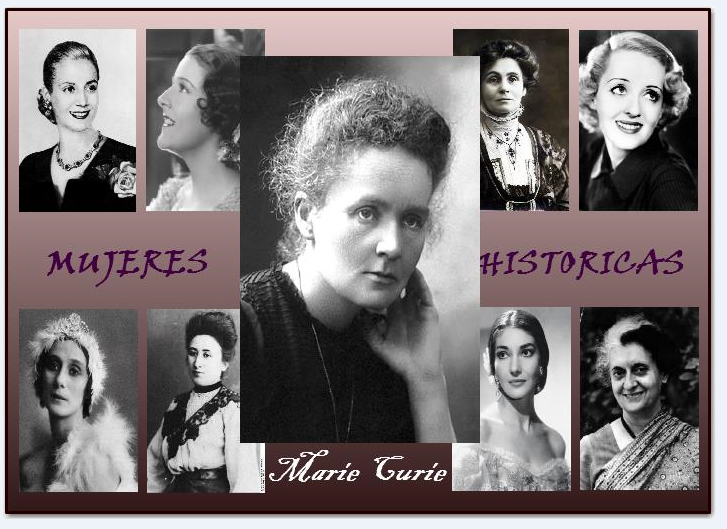
Mujeres para la Historia - VII - Marie Curie
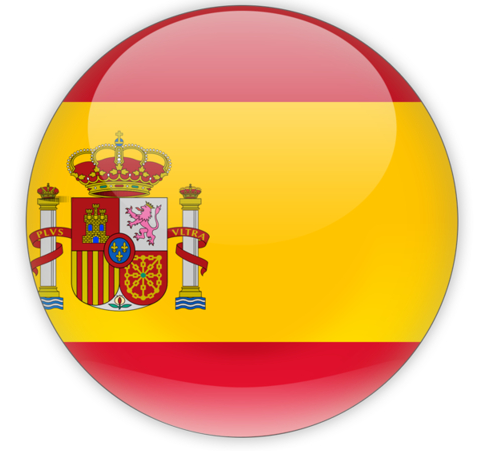
Sinopsis
María Sklodowska nace el 7 de noviembre de 1867, en Varsovia, Polonia, Marie Curie fue la primera mujer en ganar un Premio Nobel y la única mujer en ganar el premio en dos campos diferentes (física y química). Los esfuerzos de Curie, con su marido Pierre Curie, condujeron al descubrimiento del polonio y el radio y, después de la muerte de Pierre, a un mayor desarrollo de las radiografías. Murió el 4 de julio 1934.
Vida temprana
María Sklodowska, más conocida como Marie Curie, nació en Varsovia en la actual Polonia, el 7 de noviembre de 1867. Sus padres eran maestros, y ella era la menor de cinco hermanos, Zosia, Józef, Bronya y Hela. Curie se parecía a su padre, Wladyslaw, un instructor de matemáticas y física. Ella tenía una mente brillante y curiosa y sobresalió en la escuela. Pero la tragedia golpeó tempranoa la familia, y cuando ella tenía sólo 10 años perdió a su madre, Bronislawa, debido a la tuberculosis.
Siendo la mejor estudiante de su escuela secundaria, Curie no pudo asistir junto a los hombres a la Universidad de Varsovia. Ella continuó su educación en un lugar de en Varsovia conocido como la "universidad flotante", un conjunto de clases semi clandestinas, informales ymantenidas en secreto. Tanto Curie como su hermana Bronya soñaban con ir al extranjero para ganar un título oficial, pero carecían de los recursos financieros para pagar su costosa educación. Sin desesèrarse, Curie llegó a un acuerdo con su hermana. Que iba a trabajar para apoyar a Bronya mientras ella estaba en la escuela y Bronya devolvería el favor después de haber completado sus estudios.
Durante aproximadamente cinco años, Curie trabajó como tutora e institutriz. Ella utiliza su tiempo libre para estudiar, leer acerca de la física, la química y las matemáticas. En 1891, Curie finalmente se dirigió a París, donde se inscribió en la Sorbona de París. Se volcó en sus estudios, pero esta dedicación tenido un coste personal. Con poco dinero, Curie sobrevivió a base de pan y té con mantequilla, y su salud a veces sufrió a causa de su mala alimentación.
Curie completó su maestría en física en 1893 y ganó otro título en matemáticas el año siguiente. Alrededor de este tiempo, recibió el encargo de hacer un estudio sobre los diferentes tipos de acero y sus propiedades magnéticas. Curie necesitaba un laboratorio para trabajar , y un colega le presentó al físico francés Pierre Curie. Un romance sedesarrolló entre entre esta brillante pareja, y se convirtieron en además en una potente unión científica. La pareja se casó el 26 de julio de 1895

Descubrimientos
Marie y Pierre Curie eran científicos dedicados por completo dedicado a ellos y a su obra. Al principio, ellos trabajaron en proyectos separados. Estaba fascinada con la obra de Henri Becquerel, físico francés que descubrió que el uranio desprende rayos, rayos más débiles que los rayos X y que fueron descubiertos por Wilhelm Conrad Roentgen.
Curie tomó el trabajo de Becquerel unos pasos más allá, llevando a cabo sus propios experimentos sobre los rayos de uranio. Ella descubrió que los rayos se mantenían constantes, independientemente de la condición o la forma del uranio. Los rayos, que teorizó, vinieron de la estructura atómica del elemento. Esta idea revolucionaria creó el campo de la física atómica y Curie misma acuñó la palabra radiactividad para describir los fenómenos. Marie y Pierre tuvieron una hija, Irene, en 1897, pero su trabajo no se detuvo.
Pierre dejó a un lado su propio trabajo para ayudar a Marie con su exploración de la radiactividad. Trabajando con la pechblenda mineral, la pareja descubrió un nuevo elemento radiactivo en 1898. La llamaron polonio, un homenaje a la tierra natal de Marie. También detectaron la presencia de otro material radiactivo en la pechblenda, el radion. En 1902, los Curie anunciaron que habían producido un decigramo de radio puro, lo que demuestra su existencia como un elemento químico único.
La ciencia de la celebridad
Marie Curie hizo historia en 1903 al convertirse en la primera mujer en recibir el Premio Nobel de Física. Ella ganó el prestigioso honor junto con su marido y Henri Becquerel, por su trabajo sobre la radiactividad. Con su hazaña, Curie desarrolló una reputación internacional por sus esfuerzos científicos, y usó el dinero del premio para continuar su investigación. Dieron la bienvenida a una segunda hija, Eva, el año siguiente.
En 1906, Marie sufrió una pérdida tremenda. Su marido Pierre murió en París después de que accidentalmente se puso delante de un carro tirado por caballos. A pesar de su gran dolor, se hizo cargo de su puesto de profesor en la Sorbona, convirtiéndose en la primera mujer profesora de la institución.
Curie recibió otro gran honor en 1911, ganando su segundo Premio Nobel, esta vez en química. Ella fue seleccionada por su descubrimiento del radio y el polonio, y se convirtió en el primer científico en ganar dos premios Nobel. Aunque ella recibió el premio en solitario, compartió el honor junto con su difunto marido en su conferencia de aceptación.
Alrededor de este tiempo, Curie se unió con otros científicos famosos, como Albert Einstein y Max Planck, para asistir al primer Congreso Solvay de Física. Se reunieron para discutir los muchos descubrimientos innovadores en su campo. Curie experimentó el lado negativo de la fama en 1911, cuando su relación con un ex estudiante de su marido, Paul Langevin, se hizo público. Curie fue acusada en la prensa por romper el matrimonio de Langevin. Sin embargo, lanegatividad de la prensa hacia Curie deriva al menos en parte, de la creciente xenofobia en Francia.
Cuando la Primera Guerra Mundial estalló en 1914, Curie dedicó su tiempo y recursos para ayudar a la causa. Ella defendió el uso de máquinas portátiles de rayos X en el campo, y estos vehículos médicos recibieron el apodo de "Pequeños Curie". Después de la guerra, Curie utiliza su fama para avanzar en su investigación. Ella viajó a los Estados Unidos dos veces, en 1921 y en 1929 para recaudar fondos para comprar el radio y para establecer un instituto de investigación de radio en Varsovia.
"El uso de los rayos X durante la guerra salvó la vida de muchos hombres heridos; También salvó a muchos de mucho sufrimiento enfermedad duradera. "- Marie Curie
Días finales y legado
Todos sus años de trabajo con materiales radiactivos afectó negativamente a la salud de Curie. Ella era conocida por llevar a tubos de ensayo de radio alrededor en el bolsillo de su bata de laboratorio. En 1934, Curie fue al sanatorio Sancellemoz en Passy, Francia, para tratar de descansar y recuperar su fuerza. Murió allí el 4 de julio de 1934, de anemia aplásica, que pudo ser causada por la exposición prolongada a la radiación.
Marie Curie realizó muchos avances científicos en su vida. Ella es la más famosa mujer de ciencias de todos los tiempos, y ha recibido numerosos honores póstumos. En 1995, ella y los restos de su marido fueron enterrados en el Panteón de París, el lugar de descanso final de las mentes más grandes de Francia. Curie se convirtió en la primera y única mujer en ser enterrada allí.
Curie también transmitió su amor por la ciencia a la siguiente generación. Su hija Irène Joliot-Curie siguió los pasos de su madre, ganadora del Premio Nobel de Química en 1935. Joliot-Curie compartió el honor con su marido Frédéric Joliot por su trabajo en la síntesis de nuevos elementos radiactivos.
Hoy en día, varias instituciones educativas y de investigación y centros médicos llevan el nombre de Curie, incluyendo el Instituto Curie y la Universidad Pierre y Marie Curie, en París.
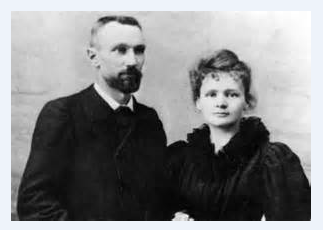
https://www.youtube.com/watch?v=qHCaP3M4yxQ

Synopsis
Born Maria Sklodowska on November 7, 1867, in Warsaw, Poland, Marie Curie became the first woman to win a Nobel Prize and the only woman to win the award in two different fields (physics and chemistry). Curie's efforts, with her husband Pierre Curie, led to the discovery of polonium and radium and, after Pierre's death, the further development of X-rays. She died on July 4, 1934.
Early Life
Maria Sklodowska, better known as Marie Curie, was born in Warsaw in modern-day Poland on November 7, 1867. Her parents were both teachers, and she was the youngest of five children, following siblings Zosia, Józef, Bronya and Hela. As a child Curie took after her father, Wladyslaw, a math and physics instructor. She had a bright and curious mind and excelled at school. But tragedy struck early, and when she was only 10, Curie lost her mother, Bronislawa, to tuberculosis.
A top student in her secondary school, Curie could not attend the men-only University of Warsaw. She instead continued her education in Warsaw's "floating university," a set of underground, informal classes held in secret. Both Curie and her sister Bronya dreamed of going abroad to earn an official degree, but they lacked the financial resources to pay for more schooling. Undeterred, Curie worked out a deal with her sister. She would work to support Bronya while she was in school and Bronya would return the favor after she completed her studies.
For roughly five years, Curie worked as a tutor and a governess. She used her spare time to study, reading about physics, chemistry and math. In 1891, Curie finally made her way to Paris where she enrolled at the Sorbonne in Paris. She threw herself into her studies, but this dedication had a personal cost. With little money, Curie survived on buttered bread and tea, and her health sometimes suffered because of her poor diet.
Curie completed her master's degree in physics in 1893 and earned another degree in mathematics the following year. Around this time, she received a commission to do a study on different types of steel and their magnetic properties. Curie needed a lab to work in, and a colleague introduced her to French physicist Pierre Curie. A romance developed between the brilliant pair, and they became a scientific dynamic duo. The pair married on July 26, 1895.
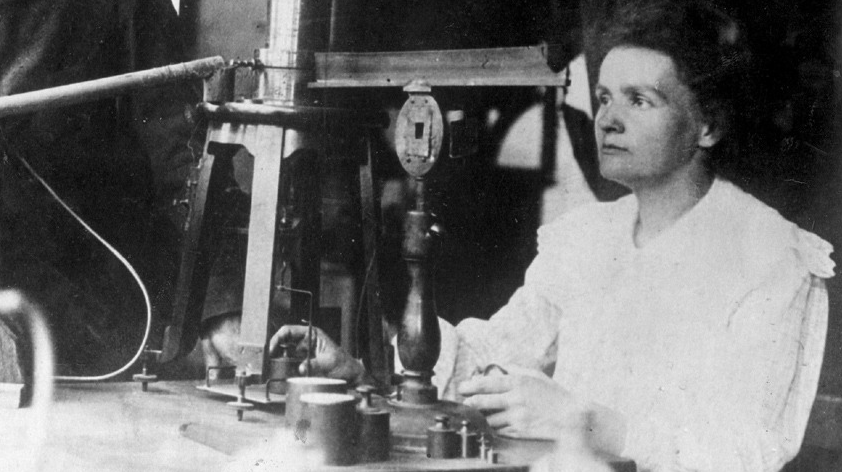
Discoveries
Marie and Pierre Curie were dedicated scientists and completely devoted to one another. At first, they worked on separate projects. She was fascinated with the work of Henri Becquerel, a French physicist who discovered that uranium casts off rays, weaker rays than the X-rays found by Wilhelm Conrad Roentgen.
Curie took Becquerel's work a few steps further, conducting her own experiments on uranium rays. She discovered that the rays remained constant, no matter the condition or form of the uranium. The rays, she theorized, came from the element's atomic structure. This revolutionary idea created the field of atomic physics and Curie herself coined the word radioactivity to describe the phenomena. Marie and Pierre had a daughter, Irene, in 1897, but their work didn't slow down.
Pierre put aside his own work to help Marie with her exploration of radioactivity. Working with the mineral pitchblende, the pair discovered a new radioactive element in 1898. They named the element polonium, after Marie's native country of Poland. They also detected the presence of another radioactive material in the pitchblende, and called that radium. In 1902, the Curies announced that they had produced a decigram of pure radium, demonstrating its existence as a unique chemical element.
Science Celebrity
Marie Curie made history in 1903 when she became the first woman to receive the Nobel Prize in physics. She won the prestigious honor along with her husband and Henri Becquerel, for their work on radioactivity. With their Nobel Prize win, the Curies developed an international reputation for their scientific efforts, and they used their prize money to continue their research. They welcomed a second child, daughter Eve, the following year.
In 1906, Marie suffered a tremendous loss. Her husband Pierre was killed in Paris after he accidentally stepped in front of a horse-drawn wagon. Despite her tremendous grief, she took over his teaching post at the Sorbonne, becoming the institution's first female professor.
Curie received another great honor in 1911, winning her second Nobel Prize, this time in chemistry. She was selected for her discovery of radium and polonium, and became the first scientist to win two Nobel Prizes. While she received the prize alone, she shared the honor jointly with her late husband in her acceptance lecture.
Around this time, Curie joined with other famous scientists, including Albert Einstein and Max Planck, to attend the first Solvay Congress in Physics. They gathered to discuss the many groundbreaking discoveries in their field. Curie experienced the downside of fame in 1911, when her relationship with her husband's former student, Paul Langevin, became public. Curie was derided in the press for breaking up Langevin's marriage. The press' negativity towards Curie stemmed at least in part from rising xenophobia in France.
When World War I broke out in 1914, Curie devoted her time and resources to helping the cause. She championed the use of portable X-ray machines in the field, and these medical vehicles earned the nickname "Little Curies." After the war, Curie used her celebrity to advance her research. She traveled to the United States twice— in 1921 and in 1929— to raise funds to buy radium and to establish a radium research institute in Warsaw.
“The use of the X-rays during the war saved the lives of many wounded men; it also saved many from long suffering and lasting infirmity.” -- Marie Curie
Final Days and Legacy
All of her years of working with radioactive materials took a toll on Curie's health. She was known to carry test tubes of radium around in the pocket of her lab coat. In 1934, Curie went to the Sancellemoz Sanatorium in Passy, France, to try to rest and regain her strength. She died there on July 4, 1934, of aplastic anemia, which can be caused by prolonged exposure to radiation.
Marie Curie made many breakthroughs in her lifetime. She is the most famous female scientist of all time, and has received numerous posthumous honors. In 1995, her and her husband's remains were interred in the Panthéon in Paris, the final resting place of France's greatest minds. Curie became the first and only woman to be laid to rest there.
Curie also passed down her love of science to the next generation. Her daughter Irène Joliot-Curie followed in her mother's footsteps, winning the Nobel Prize in Chemistry in 1935. Joliot-Curie shared the honor with her husband Frédéric Joliot for their work on their synthesis of new radioactive elements.
Today several educational and research institutions and medical centers bear the Curie name, including the Institute Curie and the Pierre and Marie Curie University, both in Paris.
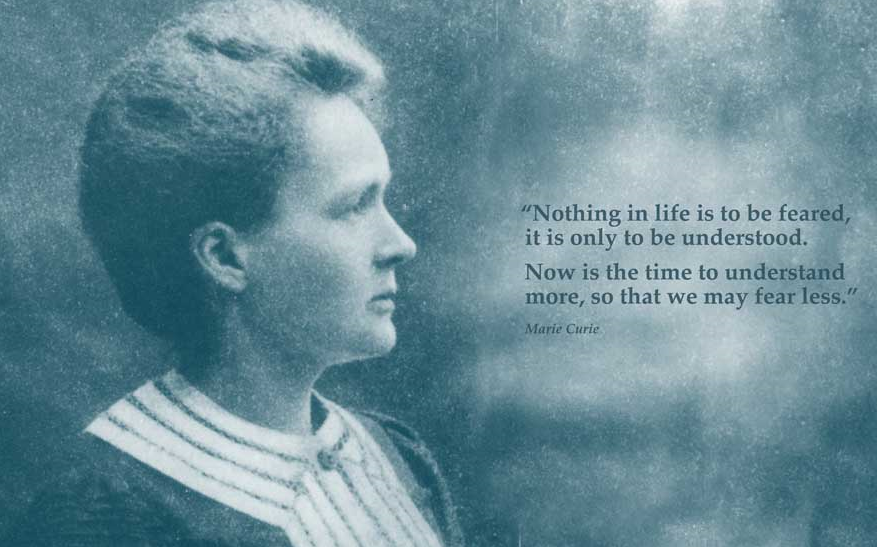
https://www.youtube.com/watch?v=qHCaP3M4yxQ

